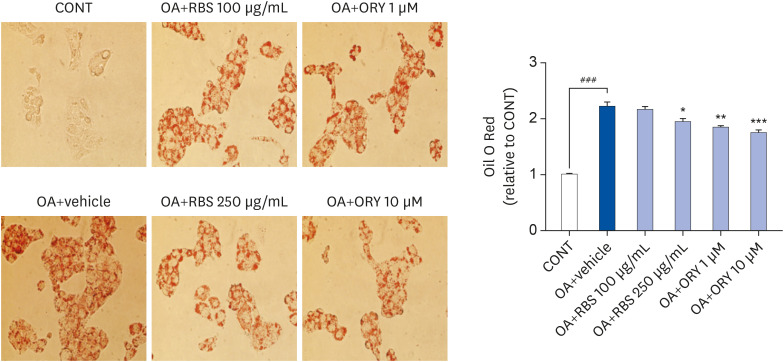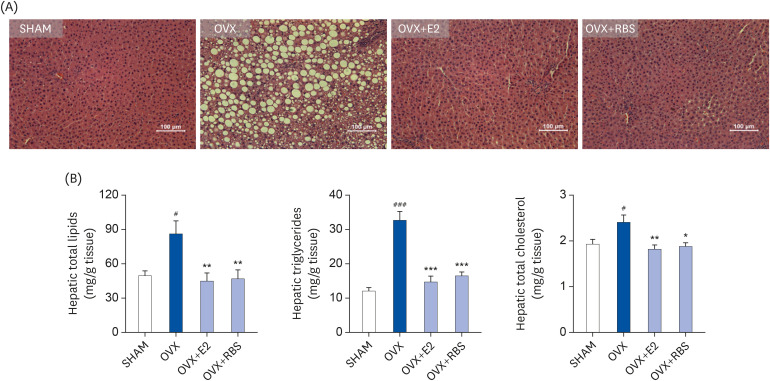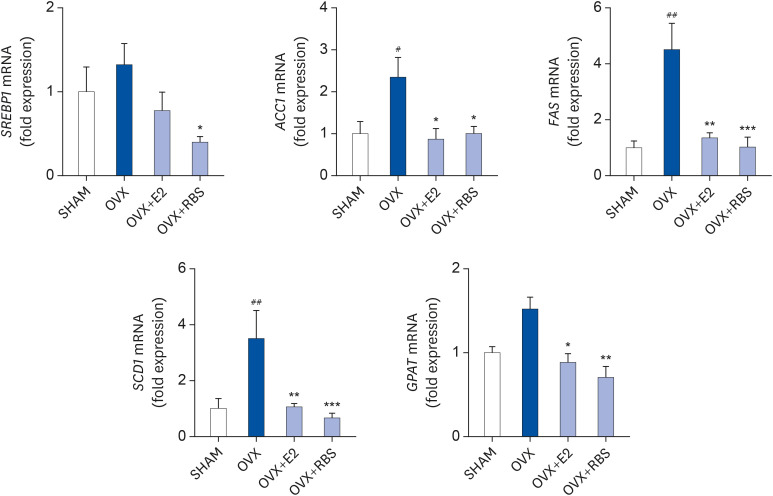1. Farrell GC, Larter CZ. Nonalcoholic fatty liver disease: from steatosis to cirrhosis. Hepatology. 2006; 43:S99–S112. PMID:
16447287.

2. Singh A, Le P, Lopez R, Alkhouri N. The utility of noninvasive scores in assessing the prevalence of nonalcoholic fatty liver disease and advanced fibrosis in type 1 diabetic patients. Hepatol Int. 2018; 12:37–43. PMID:
29318450.

3. Fan JG, Kim SU, Wong VW. New trends on obesity and NAFLD in Asia. J Hepatol. 2017; 67:862–873. PMID:
28642059.

4. Summart U, Thinkhamrop B, Chamadol N, Khuntikeo N, Songthamwat M, Kim CS. Gender differences in the prevalence of nonalcoholic fatty liver disease in the Northeast of Thailand: a population-based cross-sectional study. F1000 Res. 2017; 6:1630.

5. Fu X, Xing L, Xu W, Shu J. Treatment with estrogen protects against ovariectomy-induced hepatic steatosis by increasing AQP7 expression. Mol Med Rep. 2016; 14:425–431. PMID:
27176782.

6. Gualtieri M, Cahoon SS, Paulson RJ, Shoupe D, Muderspach LI, Roman LD, Matsuo K. Surgical menopause and the increased risk of non-alcoholic fatty liver disease in patients with endometrial hyperplasia and cancer. Fertil Steril. 2015; 103:e23.

7. Walsh BW, Schiff I, Rosner B, Greenberg L, Ravnikar V, Sacks FM. Effects of postmenopausal estrogen replacement on the concentrations and metabolism of plasma lipoproteins. N Engl J Med. 1991; 325:1196–1204. PMID:
1922206.

8. Mabunga DF, Gonzales EL, Kim HJ, Choung SY. Treatment of GABA from fermented rice germ ameliorates caffeine-induced sleep disturbance in mice. Biomol Ther (Seoul). 2015; 23:268–274. PMID:
25995826.

9. Wani AA, Singh P, Shah MA, Schweiggert-Weisz U, Gul K, Wani IA. Rice starch diversity: effects on structural, morphological, thermal, and physicochemical properties-a review. Compr Rev Food Sci Food Saf. 2012; 11:417–436.

10. Laokuldilok T, Shoemaker CF, Jongkaewwattana S, Tulyathan V. Antioxidants and antioxidant activity of several pigmented rice brans. J Agric Food Chem. 2011; 59:193–199. PMID:
21141962.

11. Kahlon TS, Chow FI, Sayre RN, Betschart AA. Cholesterol-lowering in hamsters fed rice bran at various levels, defatted rice bran and rice bran oil. J Nutr. 1992; 122:513–519. PMID:
1311755.

12. Rhee YH, Rhee CH, Chung PS, Ahn JC. Anti-oxidant and anti-inflammatory effects of rice bran and green tea fermentation mixture on lipopolysaccharide-induced RAW 264.7 macrophages. Trop J Pharm Res. 2017; 16:2943–2951.

13. Nie Y, Luo F, Wang L, Yang T, Shi L, Li X, Shen J, Xu W, Guo T, Lin Q. Anti-hyperlipidemic effect of rice bran polysaccharide and its potential mechanism in high-fat diet mice. Food Funct. 2017; 8:4028–4041. PMID:
28869259.

14. Qureshi AA, Sami SA, Khan FA. Effects of stabilized rice bran, its soluble and fiber fractions on blood glucose levels and serum lipid parameters in humans with diabetes mellitus types I and II. J Nutr Biochem. 2002; 13:175–187. PMID:
11893482.

15. Cheng HH, Huang HY, Chen YY, Huang CL, Chang CJ, Chen HL, Lai MH. Ameliorative effects of stabilized rice bran on type 2 diabetes patients. Ann Nutr Metab. 2010; 56:45–51. PMID:
20016147.

16. Muhammad SI, Maznah I, Mahmud R, Zuki AB, Imam MU. Upregulation of genes related to bone formation by γ-amino butyric acid and γ-oryzanol in germinated brown rice is via the activation of GABA
B-receptors and reduction of serum IL-6 in rats. Clin Interv Aging. 2013; 8:1259–1271. PMID:
24098073.
17. Mastinu A, Bonini SA, Rungratanawanich W, Aria F, Marziano M, Maccarinelli G, Abate G, Premoli M, Memo M, Uberti D. Gamma-oryzanol prevents LPS-induced brain inflammation and cognitive impairment in adult mice. Nutrients. 2019; 11:728.

18. Høegh-Andersen P, Tankó LB, Andersen TL, Lundberg CV, Mo JA, Heegaard AM, Delaissé JM, Christgau S. Ovariectomized rats as a model of postmenopausal osteoarthritis: validation and application. Arthritis Res Ther. 2004; 6:R169–80. PMID:
15059281.
19. Yang H, Yoon M, Um MY, Lee J, Jung J, Lee C, Kim YT, Kwon S, Kim B, Cho S. Sleep-promoting effects and possible mechanisms of action associated with a standardized rice bran supplement. Nutrients. 2017; 9:512.

20. Um MY, Kim S, Jin YH, Yoon M, Yang H, Lee J, Jung J, Urade Y, Huang ZL, Kwon S, Cho S. A novel neurological function of rice bran: a standardized rice bran supplement promotes non-rapid eye movement sleep in mice through histamine H1 receptors. Mol Nutr Food Res. 2017; 61:1700316.
21. Um MY, Yang H, Han JK, Kim JY, Kang SW, Yoon M, Kwon S, Cho S. Rice bran extract supplement improves sleep efficiency and sleep onset in adults with sleep disturbance: a randomized, double-blind, placebo-controlled, polysomnographic study. Sci Rep. 2019; 9:12339. PMID:
31451704.

22. Lim DW, Kim JG, Kim YT. Effects of dietary isoflavones from Puerariae radix on lipid and bone metabolism in ovariectomized rats. Nutrients. 2013; 5:2734–2746. PMID:
23867712.

23. Lim DW, Kim YT. Anti-osteoporotic effects of
Angelica sinensis (Oliv.) Diels extract on ovariectomized rats and its oral toxicity in rats. Nutrients. 2014; 6:4362–4372. PMID:
25325255.
24. Folch J, Lees M, Sloane Stanley GH. A simple method for the isolation and purification of total lipides from animal tissues. J Biol Chem. 1957; 226:497–509. PMID:
13428781.

25. Sawada K, Rahmania H, Matsuki M, Hashimoto H, Ito J, Miyazawa T, Nakagawa K. Absorption and metabolism of γ-oryzanol, a characteristic functional ingredient in rice bran. J Nutr Sci Vitaminol (Tokyo). 2019; 65:S180–4. PMID:
31619625.

26. Jones ME, Thorburn AW, Britt KL, Hewitt KN, Wreford NG, Proietto J, Oz OK, Leury BJ, Robertson KM, Yao S, Simpson ER. Aromatase-deficient (ArKO) mice have a phenotype of increased adiposity. Proc Natl Acad Sci U S A. 2000; 97:12735–12740. PMID:
11070087.

27. Weigt C, Hertrampf T, Flenker U, Hülsemann F, Kurnaz P, Fritzemeier KH, Diel P. Effects of estradiol, estrogen receptor subtype-selective agonists and genistein on glucose metabolism in leptin resistant female Zucker diabetic fatty (ZDF) rats. J Steroid Biochem Mol Biol. 2015; 154:12–22. PMID:
26134426.

28. Heine PA, Taylor JA, Iwamoto GA, Lubahn DB, Cooke PS. Increased adipose tissue in male and female estrogen receptor-alpha knockout mice. Proc Natl Acad Sci U S A. 2000; 97:12729–12734. PMID:
11070086.

29. Lavoie JM, Pighon A. NAFLD, estrogens, and physical exercise: the animal model. J Nutr Metab. 2012; 2012:914938. PMID:
21845221.

30. Oliveira MC, Campos-Shimada LB, Marçal-Natali MR, Ishii-Iwamoto EL, Salgueiro-Pagadigorria CL. A long-term estrogen deficiency in ovariectomized mice is associated with disturbances in fatty acid oxidation and oxidative stress. Rev Bras Ginecol Obstet. 2018; 40:251–259. PMID:
29913542.

31. Campos LB, Gilglioni EH, Garcia RF, Brito MN, Natali MR, Ishii-Iwamoto EL, Salgueiro-Pagadigorria CL.
Cimicifuga racemosa impairs fatty acid β-oxidation and induces oxidative stress in livers of ovariectomized rats with renovascular hypertension. Free Radic Biol Med. 2012; 53:680–689. PMID:
22684021.
32. Charatcharoenwitthaya P, Lindor KD, Angulo P. The spontaneous course of liver enzymes and its correlation in nonalcoholic fatty liver disease. Dig Dis Sci. 2012; 57:1925–1931. PMID:
22373863.

33. Chong CL, Hussan F, Othman F. Hepatoprotective effects of
Morinda citrifolia leaf extract on ovariectomized rats fed with thermoxidized palm oil diet: evidence at histological and ultrastructural level. Oxid Med Cell Longev. 2019; 2019:9714302. PMID:
31827717.
34. Koshy SM, Bobby Z, Jacob SE, Ananthanarayanan PH, Sridhar MG, Paulose DT. Amla prevents fructose-induced hepatic steatosis in ovariectomized rats: role of liver FXR and LXRα. Climacteric. 2015; 18:299–310. PMID:
24940994.

35. Watanabe M, Houten SM, Wang L, Moschetta A, Mangelsdorf DJ, Heyman RA, Moore DD, Auwerx J. Bile acids lower triglyceride levels via a pathway involving FXR, SHP, and SREBP-1c. J Clin Invest. 2004; 113:1408–1418. PMID:
15146238.

36. Kohjima M, Enjoji M, Higuchi N, Kato M, Kotoh K, Yoshimoto T, Fujino T, Yada M, Yada R, Harada N, Takayanagi R, Nakamuta M. Re-evaluation of fatty acid metabolism-related gene expression in nonalcoholic fatty liver disease. Int J Mol Med. 2007; 20:351–358. PMID:
17671740.

37. Flowers MT, Ntambi JM. Role of stearoyl-coenzyme A desaturase in regulating lipid metabolism. Curr Opin Lipidol. 2008; 19:248–256. PMID:
18460915.

38. Kotronen A, Seppänen-Laakso T, Westerbacka J, Kiviluoto T, Arola J, Ruskeepää AL, Oresic M, Yki-Järvinen H. Hepatic stearoyl-CoA desaturase (SCD)-1 activity and diacylglycerol but not ceramide concentrations are increased in the nonalcoholic human fatty liver. Diabetes. 2009; 58:203–208. PMID:
18952834.

39. Cao J, Li JL, Li D, Tobin JF, Gimeno RE. Molecular identification of microsomal acyl-CoA:glycerol-3-phosphate acyltransferase, a key enzyme in
de novo triacylglycerol synthesis. Proc Natl Acad Sci U S A. 2006; 103:19695–19700. PMID:
17170135.
40. Thuresson ER. Inhibition of glycerol-3-phosphate acyltransferase as a potential treatment for insulin resistance and type 2 diabetes. Curr Opin Investig Drugs. 2004; 5:411–418.
41. Panneerselvam S, Packirisamy RM, Bobby Z, Elizabeth Jacob S, Sridhar MG. Soy isoflavones (
Glycine max) ameliorate hypertriglyceridemia and hepatic steatosis in high fat-fed ovariectomized Wistar rats (an experimental model of postmenopausal obesity). J Nutr Biochem. 2016; 38:57–69. PMID:
27723468.
42. Kamei Y, Suzuki M, Miyazaki H, Tsuboyama-Kasaoka N, Wu J, Ishimi Y, Ezaki O. Ovariectomy in mice decreases lipid metabolism-related gene expression in adipose tissue and skeletal muscle with increased body fat. J Nutr Sci Vitaminol (Tokyo). 2005; 51:110–117. PMID:
16022198.

43. Hao CL, Lin HL, Ke LY, Yen HW, Shen KP. Pre-germinated brown rice extract ameliorates high-fat diet-induced metabolic syndrome. J Food Biochem. 2019; 43:e12769. PMID:
31353547.

44. Perez-Ternero C, Claro C, Parrado J, Herrera MD, Alvarez de Sotomayor M. Rice bran enzymatic extract reduces atherosclerotic plaque development and steatosis in high-fat fed ApoE
−/− mice. Nutrition. 2017; 37:22–29. PMID:
28359358.
45. Jung TD, Shin GH, Kim JM, Choi SI, Lee JH, Lee SJ, Park SJ, Woo KS, Oh SK, Lee OH. Comparative analysis of γ-oryzanol, β-glucan, total phenolic content and antioxidant activity in fermented rice bran of different varieties. Nutrients. 2017; 9:571.

46. Justo ML, Rodriguez-Rodriguez R, Claro CM, Alvarez de Sotomayor M, Parrado J, Herrera MD. Water-soluble rice bran enzymatic extract attenuates dyslipidemia, hypertension and insulin resistance in obese Zucker rats. Eur J Nutr. 2013; 52:789–797. PMID:
22661284.

47. Wang O, Liu J, Cheng Q, Guo X, Wang Y, Zhao L, Zhou F, Ji B. Effects of ferulic acid and γ-oryzanol on high-fat and high-fructose diet-induced metabolic syndrome in rats. PLoS One. 2015; 10:e0118135. PMID:
25646799.

48. Wang L, Lin Q, Yang T, Liang Y, Nie Y, Luo Y, Shen J, Fu X, Tang Y, Luo F. Oryzanol modifies high fat diet-induced obesity, liver gene expression profile, and inflammation response in mice. J Agric Food Chem. 2017; 65:8374–8385. PMID:
28853872.

49. Song L, Qu D, Zhang Q, Jiang J, Zhou H, Jiang R, Li Y, Zhang Y, Yan H. Phytosterol esters attenuate hepatic steatosis in rats with non-alcoholic fatty liver disease rats fed a high-fat diet. Sci Rep. 2017; 7:41604. PMID:
28169366.











 PDF
PDF Citation
Citation Print
Print




 XML Download
XML Download